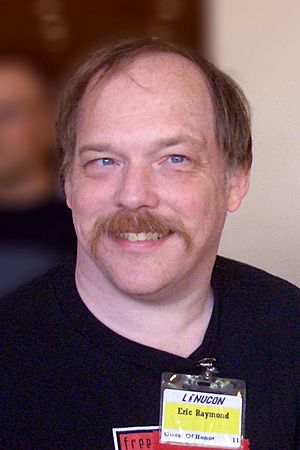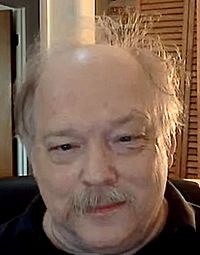Eric S. Raymond facts for kids
Quick facts for kids
Eric S. Raymond
|
|
|---|---|

Raymond at Linucon in 2004
|
|
| Born | December 4, 1957 Boston, Massachusetts, US
|
| Alma mater | University of Pennsylvania |
| Occupation | Software developer, author |
| Top - 0-9 A B C D E F G H I J K L M N O P Q R S T U V W X Y Z |
Eric Steven Raymond (born December 4, 1957), often called ESR, is an American software developer and writer. He is well-known for his ideas about open-source software. This is software that anyone can use, change, and share freely.
Raymond wrote an important essay and book called The Cathedral and the Bazaar. He also helped update the Jargon File, which is like a dictionary of terms used by computer programmers.
Early Life and Interests
Eric Raymond was born in Boston, Massachusetts in 1957. When he was a child, he lived in Venezuela. His family later moved to Pennsylvania in 1971.
Raymond was born with cerebral palsy, a condition that affects movement. This physical challenge encouraged him to explore the world of computers.
Career in Software
Raymond started his programming work writing software that people had to pay for. This was between 1980 and 1985.
In 1990, he noticed that the Jargon File had not been updated for many years. He decided to take over and update it. This updated version was published as The New Hacker's Dictionary.
Developing Open-Source Ideas
In 1996, Raymond began working on an open-source email program called "popclient." He later renamed it Fetchmail. This experience gave him many ideas about how software should be made.
In 1997, he wrote his famous essay, "The Cathedral and the Bazaar." In this essay, he explained his thoughts on open-source software development. He believed that software should be developed openly, like a busy "bazaar," rather than secretly, like a "cathedral."
He first shared these ideas at a computer conference called Linux Kongress. Later, he turned his essay into a book in 1999. This book became very popular and influenced many people in the software world. For example, it helped convince Netscape to release its web browser code as open source in 1998.
Leading the Open Source Movement
Because his essay was so popular, Raymond became a key leader in the open source movement. In 1998, he helped start the Open Source Initiative (OSI). This organization works to promote open source software.
He acted as an ambassador for open source, talking to the media and businesses. He was president of the OSI until 2005.
In 1998, Raymond also shared some secret documents from Microsoft. These documents showed that Microsoft was worried about how good rival open-source software was. He called these documents "The Halloween Documents."
Other Software Projects
Between 2000 and 2002, Raymond created a system for organizing source code called Configuration Menu Language 2 (CML2). While it was meant for the Linux kernel, the main part of the Linux operating system, it was not used by the kernel developers.
His 2003 book, The Art of Unix Programming, talks about tools that programmers use. Raymond has also helped with the free software video game The Battle for Wesnoth.
He is also the main developer of NTPsec. This is a more secure version of a computer tool called NTP, which helps keep computer clocks accurate. Raymond has also created other open-source tools for managing code, like cvs-fast-export and reposurgeon.
Views on Open Source
Raymond came up with a famous saying called Linus's law, inspired by Linus Torvalds. The saying is: "Given enough eyeballs, all bugs are shallow." This means that if many people look at software code, it's easier to find and fix mistakes. This idea first appeared in his book The Cathedral and the Bazaar.
Raymond believes that promoting open-source software works best when people focus on how useful it is. He thinks it's better to show how open source leads to better products. He has had some disagreements with others in the free software movement who focus more on moral reasons for using free software.
In 2008, he wrote that programmers should have the right to sell their software if they want to. He believes that if someone creates a program, they should decide how it is sold.
Political Beliefs
Raymond is a member of the Libertarian Party. He also supports gun rights. He has supported groups that work on open-source firearms, saying they are "friends of freedom." He believes that making it harder for governments to control force is a good step.
Religious Beliefs
Eric Raymond describes himself as neo-pagan, which is a type of modern religious belief.
See also
 In Spanish: Eric S. Raymond para niños
In Spanish: Eric S. Raymond para niños
- Hacker ethic
- Halloween documents
- Release early, release often
- Revolution OS (film)


